Factors Influencing the Spatial Distribution of Soil Total Phosphorus Based on Structural Equation Modeling
Abstract
1. Introduction
2. Materials and Methods
2.1. Overview of the Study Area
2.2. Soil Sample Collection and Processing
2.3. Data Sources and Data Processing
2.4. Research Methodology
2.4.1. Classical Statistics
2.4.2. Geostatistics
2.4.3. Method of Influencing Factor Analysis
3. Results and Analysis
3.1. Descriptive Statistical Analysis
3.2. Characterization of Spatial Variability in Soil Total Phosphorus
3.3. Analysis of Factors Influencing the Spatial Distribution of Soil Total Phosphorus
3.3.1. Pearson Correlation Analysis
3.3.2. One-Way Analysis of Variance
3.3.3. Structural Equation Modeling Analysis
4. Discussion
4.1. Main Factors and Mechanisms Affecting the Spatial Distribution of Soil Total Phosphorus
4.2. Recommendations for Controlling Soil Total Phosphorus in the Study Area
5. Conclusions
Supplementary Materials
Author Contributions
Funding
Institutional Review Board Statement
Data Availability Statement
Conflicts of Interest
References
- Malhotra, H.; Vandana Sharma, S.; Pandey, R. Phosphorus Nutrition: Plant Growth in Response to Deficiency and Excess. In Plant Nutrients and Abiotic Stress Tolerance; Springer: Cham, Switzerland, 2018; pp. 171–190. [Google Scholar]
- Yanardağ, A.B. Damage to Soil and Environment Caused by Excessive Fertilizer Use. In Agriculture, Forestry and Aquaculture Sciences; Serüven Publishing: Ankara, Turkey, 2024; p. 203. [Google Scholar]
- Chen, M.; Li, Y.; Wang, C.; Walter, M.T.; Huang, L. Modelling rainfall-induced phosphorus loss with eroded clay and surface runoff. Hydrol. Process. 2023, 37, e14817. [Google Scholar] [CrossRef]
- Han, J.; Xin, Z.; Han, F.; Xu, B.; Wang, L.; Zhang, C.; Zheng, Y. Source contribution analysis of nutrient pollution in a P-rich watershed: Implications for integrated water quality management. Environ. Pollut. 2021, 279, 116885. [Google Scholar] [CrossRef]
- Foy, R.; Withers, P. The contribution of agricultural phosphorus to eutrophication. Proc. Fertil. Soc. 1995, 365, 1–32. [Google Scholar]
- Liu, Z.-P.; Shao, M.-A.; Wang, Y.-Q. Spatial patterns of soil total nitrogen and soil total phosphorus across the entire Loess Plateau region of China. Geoderma 2013, 197, 67–78. [Google Scholar] [CrossRef]
- Roger, A.; Libohova, Z.; Rossier, N.; Joost, S.; Maltas, A.; Frossard, E.; Sinaj, S. Spatial variability of soil phosphorus in the Fribourg canton, Switzerland. Geoderma 2014, 217, 26–36. [Google Scholar] [CrossRef]
- Wang, J.; Ouyang, J.; Zhang, M. Spatial distribution characteristics of soil and vegetation in a reclaimed area in an opencast coalmine. Catena 2020, 195, 104773. [Google Scholar] [CrossRef]
- Thuy, P.T.P.; Hoa, N.M.; Dick, W.A. Reducing phosphorus fertilizer input in high phosphorus soils for sustainable agriculture in the Mekong Delta, Vietnam. Agriculture 2020, 10, 87. [Google Scholar] [CrossRef]
- He, X.; Augusto, L.; Goll, D.S.; Ringeval, B.; Wang, Y.; Helfenstein, J.; Huang, Y.; Yu, K.; Wang, Z.; Yang, Y.J.C.G. Global patterns and drivers of soil total phosphorus concentration. Earth Syst. Sci. Data Discuss 2021, 13, 5831–5846. [Google Scholar] [CrossRef]
- Rubæk, G.H.; Kristensen, K.; Olesen, S.E.; Østergaard, H.S.; Heckrath, G. Phosphorus accumulation and spatial distribution in agricultural soils in Denmark. Geoderma 2013, 209, 241–250. [Google Scholar] [CrossRef]
- Li, C.; Zhang, Y.; Fang, H. Changes of Total Phosphorus in Topsoil and the Correlations with Agricultural Land-Use Change Across the Chengdu Plain During the Past 40 Years. Chin. J. Soil Sci. 2022, 53, 187–194. [Google Scholar] [CrossRef]
- Zhu, J.; Wu, A.; Zhou, G. Spatial distribution patterns of soil total phosphorus influenced by climatic factors in China’s forest ecosystems. Sci. Rep. 2021, 11, 5357. [Google Scholar] [CrossRef]
- Han, Y.; Guo, X.; Jiang, Y.; Xu, Z.; Li, Z. Environmental factors influencing spatial variability of soil total phosphorus content in a small watershed in Poyang Lake Plain under different levels of soil erosion. Catena 2020, 187, 104357. [Google Scholar] [CrossRef]
- Wang, R.; Zou, R.; Liu, J.; Liu, L.; Hu, Y. Spatial distribution of soil nutrients in farmland in a hilly region of the pearl river delta in China based on geostatistics and the inverse distance weighting method. Agriculture 2021, 11, 50. [Google Scholar] [CrossRef]
- Biswas, A.; Biswas, A. Geostatistics in soil science: A comprehensive review on past, present and future perspectives. J. Indian Soc. Soil Sci. 2024, 72, 1–22. [Google Scholar] [CrossRef]
- Gao, L.; Zhang, D.; Long, H.; Chen, X.; Lin, C.; Zhou, T. Interaction mechanism of climate, vegetation and soil factors on soil organic carbon at different soil depths in Ningxia. Acta Ecol. Sin. 2023, 43, 10081–10091. [Google Scholar] [CrossRef]
- Yu, T.; Qian, H.; Zhou, Y.; Yang, M. Spatial distribution characteristics and influencing factors of soil nitrogen in damaged wetland in double-returned area of Poyang Lake. Acta Agric. Univ. Jiangxiensis 2024, 46, 530–542. [Google Scholar] [CrossRef]
- Li, B.; Yang, G.; Wan, R.; Lai, X.; Wagner, P.D. Impacts of hydrological alteration on ecosystem services changes of a large river-connected lake (Poyang Lake), China. J. Environ. Manag. 2022, 310, 114750. [Google Scholar] [CrossRef]
- Li, B.; Yang, G.; Wan, R. Multidecadal water quality deterioration in the largest freshwater lake in China (Poyang Lake): Implications on eutrophication management. Environ. Pollut. 2020, 260, 114033. [Google Scholar] [CrossRef]
- Wu, Y.; Wang, H.; Deng, Y.; Li, X.; Xu, H. Evaluation and driving characteristics of water nutrients in Poyang lack based on TLI method. Environ. Eng. 2024, 42, 10–17. [Google Scholar] [CrossRef]
- Shao, X. Regulations of Jiangxi Province on the Prevention and Control of Total Phosphorus Pollution in the Poyang Lake Basin. 30 November 2023. Available online: https://jxrd.jxnews.com.cn/system/2023/11/30/020317181.shtml (accessed on 18 February 2024).
- Zhou, Y.; Zhao, X.; Guo, X. Influence Factors Analysis of Soil Trace Elements in Xunwu County Based on the Geographical Detector. J. Nucl. Agric. Sci. 2021, 35, 1420–1432. [Google Scholar] [CrossRef]
- Balasubramanian, A. Digital Elevation Model (DEM) in GIS; University of Mysore: Mysore, India, 2017. [Google Scholar]
- Borana, S.; Yadav, S. tpi-Based Vegetation Changes and Seasonal Variation in Semi Arid Region. In Proceedings of the ESRI India Conference-2018, Kolkata, India, 6 September 2018. [Google Scholar]
- Jiang, Y.; Rao, L.; Guo, X. Spatial Variability of Farmland Soil Nitrogen of Jiangxi Province and Its Influencing Factors. Resour. Environ. Yangtze Basin 2018, 27, 70–79. [Google Scholar] [CrossRef]
- Nielsen, D.R.; Bouma, J. Soil Spatial Variability: Proceedings of a Workshop of the ISSS and the SSSA, Las Vegas, USA/Pdc296; Center Agricultural Pub and Document, Pudoc Wageningen: Wageningen, The Netherlands, 1985. [Google Scholar]
- Xu, Y.; Sun, H.; Ji, X. Spatial-temporal evolution and driving forces of rainfall erosivity in a climatic transitional zone: A case in Huaihe River Basin, eastern China. Catena 2021, 198, 104993. [Google Scholar] [CrossRef]
- Zhang, C.; Lu, L.; Yang, H.; Huang, F. Spatial variation analysis of soil organic matter in karst area. Carsologica Sin. 2022, 41, 228–239. [Google Scholar]
- Wang, H.; Zhu, Y.; Wang, J.; Han, H.; Niu, J.; Chen, X. Modeling of spatial pattern and influencing factors of cultivated land quality in Henan Province based on spatial big data. PLoS ONE 2022, 17, e0265613. [Google Scholar] [CrossRef]
- Cambardella, C.A.; Moorman, T.B.; Novak, J.; Parkin, T.; Karlen, D.; Turco, R.; Konopka, A. Field-scale variability of soil properties in central Iowa soils. Soil Sci. Soc. Am. J. 1994, 58, 1501–1511. [Google Scholar] [CrossRef]
- Li, Y.; Zhong, B.; Xu, X.; Liang, Z. Application of a semivariogram based on a deep neural network to Ordinary Kriging interpolation of elevation data. PLoS ONE 2022, 17, e0266942. [Google Scholar] [CrossRef]
- Lu, X.; Yang, Q.; Wang, H.; Zhu, Y. A global meta-analysis of the correlation between soil physicochemical properties and lead bioaccessibility. J. Hazard. Mater. 2023, 453, 131440. [Google Scholar] [CrossRef] [PubMed]
- Zhu, P.; Zhang, G.; Wang, C.; Chen, S.; Wan, Y. Variation in soil infiltration properties under different land use/cover in the black soil region of Northeast China. Int. Soil Water Conserv. Res. 2024, 12, 379–387. [Google Scholar] [CrossRef]
- Yuan, K.; Deng, L. Equivalence of Partial-Least-Squares SEM and the Methods of Factor-Score Regression. Struct. Equ. Model. Multidiscip. J. 2021, 28, 557–571. [Google Scholar] [CrossRef]
- Hu, Y.; Xiang, D.; Veresoglou, S.D.; Chen, F.; Chen, Y.; Hao, Z.; Zhang, X.; Baodong, C. Soil organic carbon and soil structure are driving microbial abundance and community composition across the arid and semi-arid grasslands in northern China. Soil Biol. Biochem. 2014, 77, 51–57. [Google Scholar] [CrossRef]
- Huang, Y.; Ma, Y.; Hao, Y. Analysis of soil nutrient characteristics under typical land uses in north-eastern Ulan Buh Desert. Agric. Res. Arid. Areas 2019, 37, 123–129. [Google Scholar]
- Li, X.; Liu, T.; Zhao, C.; Shao, M.; Cheng, J. Land use drives the spatial variability of soil phosphorus in the Hexi Corridor, China. Biogeochemistry 2021, 155, 59–75. [Google Scholar] [CrossRef]
- Zhong, W.; Dong, Y.; Wang, S.; Ni, Z.; Wu, D.; Yang, Y.; Deng, Z. Evolution of watershed phosphorus buffering capacity and its response to land-use change in Poyang Lake basin, China. J. Clean. Prod. 2022, 365, 132606. [Google Scholar] [CrossRef]
- Qiu, H.; Kuai, L.; Zhang, L. Characteristics of Acidity and Nutrient Changes in Red Soil After Conversion of Paddy Field to Dry Land and Vegetable Field. Sci. Agric. Sin. 2024, 57, 525–538. [Google Scholar] [CrossRef]
- Liu, J.; Han, C.; Zhao, Y.; Yang, J.; Cade-Menun, B.J.; Hu, Y.; Li, J.; Liu, H.; Sui, P.; Chen, Y. The chemical nature of soil phosphorus in response to long-term fertilization practices: Implications for sustainable phosphorus management. J. Clean. Prod. 2020, 272, 123093. [Google Scholar] [CrossRef]
- Hu, Q.; Wang, J.; Da, Y.; Sun, Y. The effects of plastic mulching and different fertilization on soil nutrients, yield and soil microbiome in maize field. Cereal Res. Commun. 2023, 51, 773–784. [Google Scholar] [CrossRef]
- Yang, Y.; Zhang, H.; Qian, X.; Duan, J.; Wang, G. Excessive application of pig manure increases the risk of P loss in calcic cinnamon soil in China. Sci. Total Environ. 2017, 609, 102–108. [Google Scholar] [CrossRef]
- Raiesi, T.; Moradi, B. Young navel orange rootstock improves phosphorus absorption from poorly soluble pools through rhizosphere processes. Rhizosphere 2021, 17, 100316. [Google Scholar] [CrossRef]
- Yang, H.; Ji, L.; Long, L.; Ni, K.; Yang, X.; Ma, L.; Guo, S.; Ruan, J. Effect of Short-Term Phosphorus Supply on Rhizosphere Microbial Community of Tea Plants. Agronomy 2022, 12, 2405. [Google Scholar] [CrossRef]
- Zou, Z.; Mi, W.; Li, X.; Hu, Q.; Zhang, L.; Zhang, L.; Fu, J.; Li, Z.; Han, W.; Yan, P. Biochar application method influences root growth of tea (Camellia sinensis L.) by altering soil biochemical properties. Sci. Hortic. 2023, 315, 111960. [Google Scholar] [CrossRef]
- Leite, H.M.F.; Calonego, J.C.; de Moraes, M.F.; Mota, L.H.D.S.D.O.; da Silva, G.F.; do Nascimento, C.A.C. How a Long-Term Cover Crop Cultivation Impacts Soil Phosphorus Availability in a No-Tillage System? Plants 2024, 13, 2057. [Google Scholar] [CrossRef] [PubMed]
- Smil, V. Phosphorus in the environment: Natural flows and human interferences. Annu. Rev. Energy Environ. 2000, 25, 53–88. [Google Scholar] [CrossRef]
- Zhai, T.; Wang, J.; Fang, Y.; Qin, Y.; Huang, L.; Chen, Y. Assessing ecological risks caused by human activities in rapid urbanization coastal areas: Towards an integrated approach to determining key areas of terrestrial-oceanic ecosystems preservation and restoration. Sci. Total Environ. 2020, 708, 135153. [Google Scholar] [CrossRef] [PubMed]
- Chen, C.; Zhang, X.; Webster, C. Spatially Explicit Impact of Land Use Changes in the Bay Area on Anthropogenic Phosphorus Emissions and Freshwater Eutrophication Potential. Environ. Sci. Technol. 2024, 58, 18701–18712. [Google Scholar] [CrossRef]
- Xiong, J.; Lin, C.; Wu, Z.; Song, K.; Ma, R. Response of phosphorus in estuaries to soil erosion—A new insight into sediment phosphorus fractions and sources. Catena 2021, 207, 105665. [Google Scholar] [CrossRef]
- Liu, D.; Cao, K.; Tang, Y.; Zhang, J.; Meng, X.; Ao, T.; Zhang, H. Study on weathering corrosion characteristics of red sandstone of ancient buildings under the perspective of non-destructive testing. J. Build. Eng. 2024, 85, 108520. [Google Scholar] [CrossRef]
- Chen, C.; Zhao, B.; Zhang, L.; Huang, W. Mechanism of strength deterioration of red sandstone on reservoir bank slopes under the action of dry–wet cycles. Sci. Rep. 2023, 13, 20027. [Google Scholar] [CrossRef] [PubMed]
- Zhang, J. Spatial and Temporal Changes of Soil Nutrients in Typical Red Soil Erosion Region of Southern China. Ph.D. Thesis, Fujian Normal University, Fuzhou, China, 2021. [Google Scholar]
- Barrow, N. The effects of pH on phosphate uptake from the soil. Plant Soil 2017, 410, 401–410. [Google Scholar] [CrossRef]
- Devau, N.; Le Cadre, E.; Hinsinger, P.; Jaillard, B.; Gérard, F. Soil pH controls the environmental availability of phosphorus: Experimental and mechanistic modelling approaches. Appl. Geochem. 2009, 24, 2163–2174. [Google Scholar] [CrossRef]
- Huang, W.; Liu, C.; Liu, Y.; Huang, B.; Li, D.; Yuan, Z. Soil Ecological Stoichiometry and Its Influencing Factors at Different Elevations in Nanling Mountains. Ecol. Environ. Sci. 2023, 32, 80–89. [Google Scholar] [CrossRef]
- Ma, Z. Spatial Heterogeneity of Soil Phosphorus and Its Influencing Factors in Guizhou Province. Ph.D. Thesis, Guizhou Normal University, Guiyang, China, 2023. [Google Scholar]
- Von Blanckenburg, F.; Schuessler, J.; Bouchez, J.; Frings, P.; Uhlig, D.; Oelze, M.; Frick, D.A.; Hewawasam, T.; Dixon, J.; Norton, K. Rock weathering and nutrient cycling along an erodosequence. Am. J. Sci. 2021, 321, 1111–1163. [Google Scholar] [CrossRef]
- Mou, X.; Wu, Y.; Niu, Z.; Jia, B.; Guan, Z.; Chen, J.; Li, H.; Cui, H.; Kuzyakov, Y.; Li, X. Soil phosphorus accumulation changes with decreasing temperature along a 2300 m altitude gradient. Agric. Ecosyst. Environ. 2020, 301, 107050. [Google Scholar] [CrossRef]
- Hu, Y.; Raza, A.; Syed, N.R.; Acharki, S.; Ray, R.L.; Hussain, S.; Dehghanisanij, H.; Zubair, M.; Elbeltagi, A. Land use/land cover change detection and NDVI estimation in Pakistan’s Southern Punjab Province. Sustainability 2023, 15, 3572. [Google Scholar] [CrossRef]
- Olexa, E.M.; Lawrence, R.L. Performance and effects of land cover type on synthetic surface reflectance data and NDVI estimates for assessment and monitoring of semi-arid rangeland. Int. J. Appl. Earth Obs. Geoinf. 2014, 30, 30–41. [Google Scholar] [CrossRef]
- Tasser, E.; Tappeiner, U. Impact of land use changes on mountain vegetation. Appl. Veg. Sci. 2002, 5, 173–184. [Google Scholar] [CrossRef]
- Wang, Z.; Xiao, P.; Zhang, P.; Sun, W.; Li, L.; Dong, F.; Hou, X.; Ma, L.; Jin, C. Mapping Spatio-Temporal Variations of Converting Farmland to Forest/Grassland on the Loess Plateau Using All Available Landsat Time-Series Images. In Proceedings of the IGARSS 2019–2019 IEEE International Geoscience and Remote Sensing Symposium, Yokohama, Japan, 28 July–2 August 2019. [Google Scholar]
- Zhang, M.; O’Connor, P.J.; Zhang, J.; Ye, X. Linking soil nutrient cycling and microbial community with vegetation cover in riparian zone. Geoderma 2021, 384, 114801. [Google Scholar] [CrossRef]
- Arruda, B.; Herrera, W.F.B.; Rojas-García, J.C.; Turner, C.; Pavinato, P.S. Cover crop species and mycorrhizal colonization on soil phosphorus dynamics. Rhizosphere 2021, 19, 100396. [Google Scholar] [CrossRef]
- Luo, T.; Zhu, Y.; Lu, W.; Chen, L.; Min, T.; Li, J.; Wei, C. Acidic compost tea enhances phosphorus availability and cotton yield in calcareous soils by decreasing soil pH. Acta Agric. Scand. Sect. B—Soil Plant Sci. 2021, 71, 657–666. [Google Scholar] [CrossRef]
- Wang, Y.; Zhang, W.; Müller, T.; Lakshmanan, P.; Liu, Y.; Liang, T.; Wang, L.; Yang, H.; Chen, X. Soil phosphorus availability and fractionation in response to different phosphorus sources in alkaline and acid soils: A short-term incubation study. Sci. Rep. 2023, 13, 5677. [Google Scholar] [CrossRef]
- Chen, G.; Gan, L.; Wang, S.; Wan, G. Progess in geochemistry of phosphorus in soils. Earth Environ. 2001, 29, 78–81. [Google Scholar] [CrossRef]
- Krakauer, N.Y.; Lakhankar, T.; Anadón, J.D. Mapping and attributing normalized difference vegetation index trends for Nepal. Remote Sens. 2017, 9, 986. [Google Scholar] [CrossRef]
- Chen, W.; Xiao, A.; Braconnot, P.; Ciais, P.; Viovy, N.; Zhang, R. Mid-Holocene high-resolution temperature and precipitation gridded reconstructions over China: Implications for elevation-dependent temperature changes. Earth Planet. Sci. Lett. 2022, 593, 117656. [Google Scholar] [CrossRef]
- Osman, K.T. Soils on Steep Slopes. In Management of Soil Problems; Springer: Cham, Switzerland, 2018; pp. 185–217. [Google Scholar]
- Hua, D.; Li, J.; Xu, Y. Influence of Topographical Factors on Spatial Distribution Characteristics of Soil Nutrients in Qinba Mountain area. In Proceedings of the 2nd International Conference on Oil & Gas Engineering and Geological Sciences, IOP Conference Series: Earth and Environmental Science, Dalian, China, 4–5 July 2020. [Google Scholar]
- Qasim, M.; Hubacek, K.; Termansen, M.; Fleskens, L. Modelling land use change across elevation gradients in district Swat, Pakistan. Reg. Environ. Change 2013, 13, 567–581. [Google Scholar] [CrossRef]
- Birhanu, L.; Hailu, B.T.; Bekele, T.; Demissew, S. Land use/land cover change along elevation and slope gradient in highlands of Ethiopia. Remote Sens. Appl. Soc. Environ. 2019, 16, 100260. [Google Scholar] [CrossRef]
- Evans, I.S.; Cox, N.J. Relations Between Land Surface Properties: Altitude, Slope and Curvature. In Process Modelling and Landform Evolution; Springer: Cham, Switzerland, 2005; pp. 13–45. [Google Scholar]
- Warren, S.D.; Hohmann, M.G.; Auerswald, K.; Mitasova, H. An evaluation of methods to determine slope using digital elevation data. Catena 2004, 58, 215–233. [Google Scholar] [CrossRef]
- He, J.; Zhao, W.; Li, A.; Wen, F.; Yu, D. The impact of the terrain effect on land surface temperature variation based on Landsat-8 observations in mountainous areas. Int. J. Remote Sens. 2019, 40, 1808–1827. [Google Scholar] [CrossRef]
- Fan, B.; Tao, W.; Qin, G.; Hopkins, I.; Zhang, Y.; Wang, Q.; Lin, H.; Guo, L. Soil micro-climate variation in relation to slope aspect, position, and curvature in a forested catchment. Agric. For. Meteorol. 2020, 290, 107999. [Google Scholar] [CrossRef]
- Tarolli, P.; Pijl, A.; Cucchiaro, S.; Wei, W. Slope instabilities in steep cultivation systems: Process classification and opportunities from remote sensing. Land Degrad. Dev. 2021, 32, 1368–1388. [Google Scholar] [CrossRef]
- Han, X. Study on Dynamic Changes of Soil InorganicPhosphorus and Their Migration Characteristics of the Farmland in the Three Gorges Reservoir Area. Ph.D. Thesis, Southwest University, Chongqing, China, 2016. [Google Scholar]
- Nie, J.; Haitao, F.; Xian, H. Coping Strategies for Eutrophication of Dianchi Lake. Low Carbon World 2023, 13, 13–15. [Google Scholar] [CrossRef]
- Chen, J. Research on the Best Management Practices for Non-point Source Pollution in the Ashi River Basin Based on the SWAT Model. Ph.D. Thesis, Heilongjiang Universit, Harbin, China, 2023. [Google Scholar]
- Liu, L.; Zheng, X.; Wei, X.; Kai, Z.; Xu, Y. Excessive application of chemical fertilizer and organophosphorus pesticides induced total phosphorus loss from planting causing surface water eutrophication. Sci. Rep. 2021, 11, 23015. [Google Scholar] [CrossRef]
- Miao, K.; Dai, W.; Xie, Z.; Li, C.; Ye, C. Effect of Grass Buffer Strips on Nitrogen and Phosphorus Removal from Paddy Runoff and Its Optimum Widths. Agronomy 2023, 13, 2980. [Google Scholar] [CrossRef]
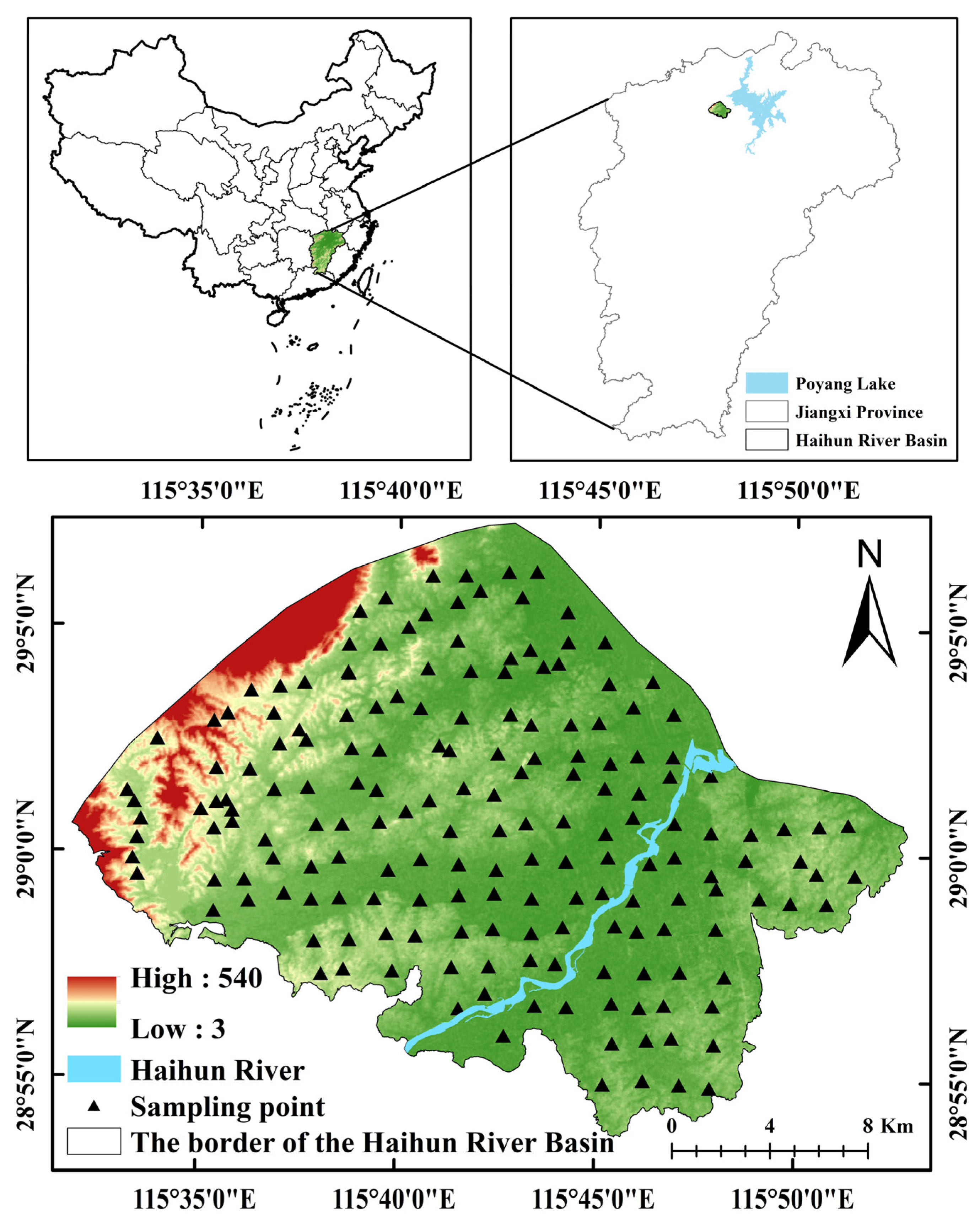
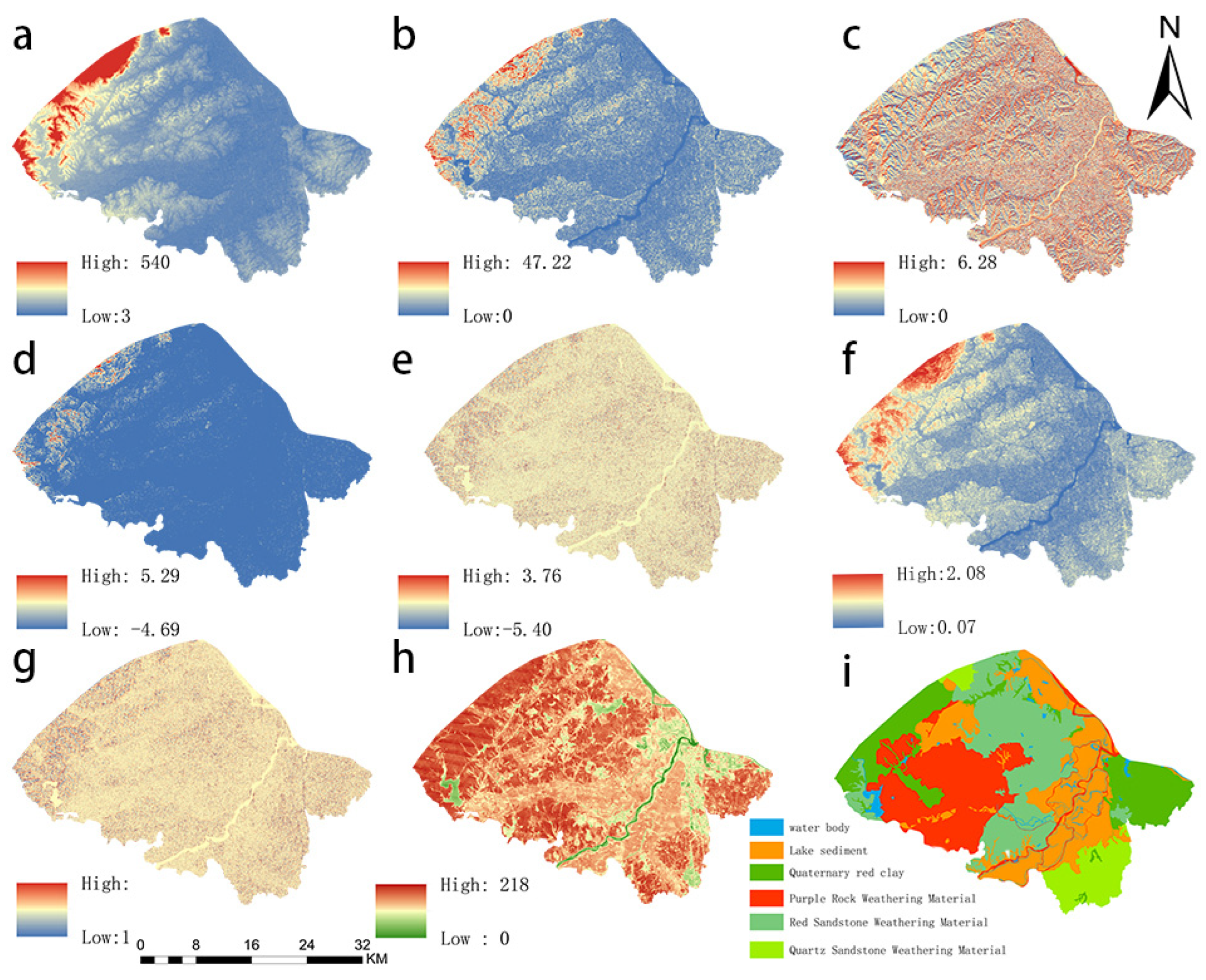
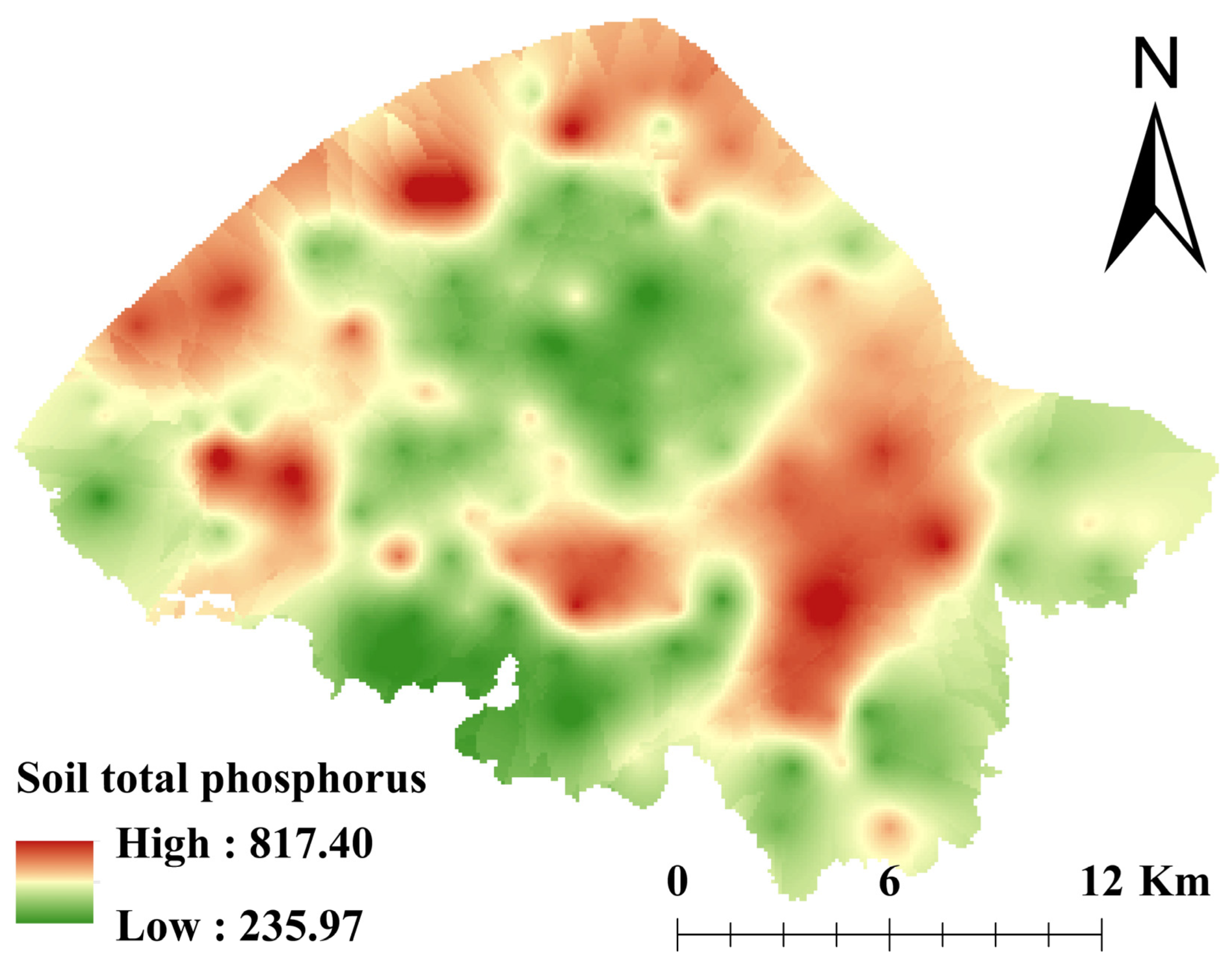
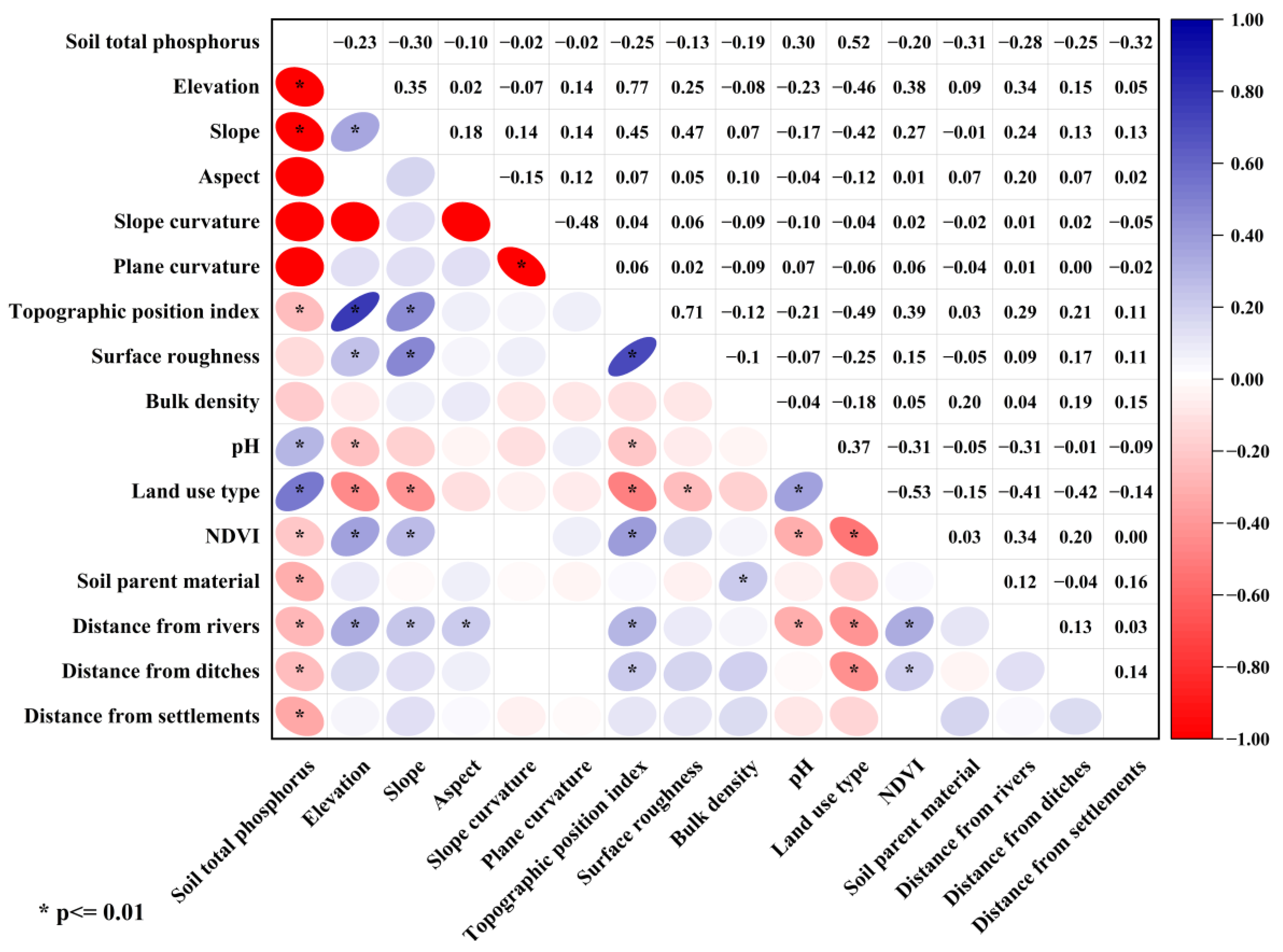
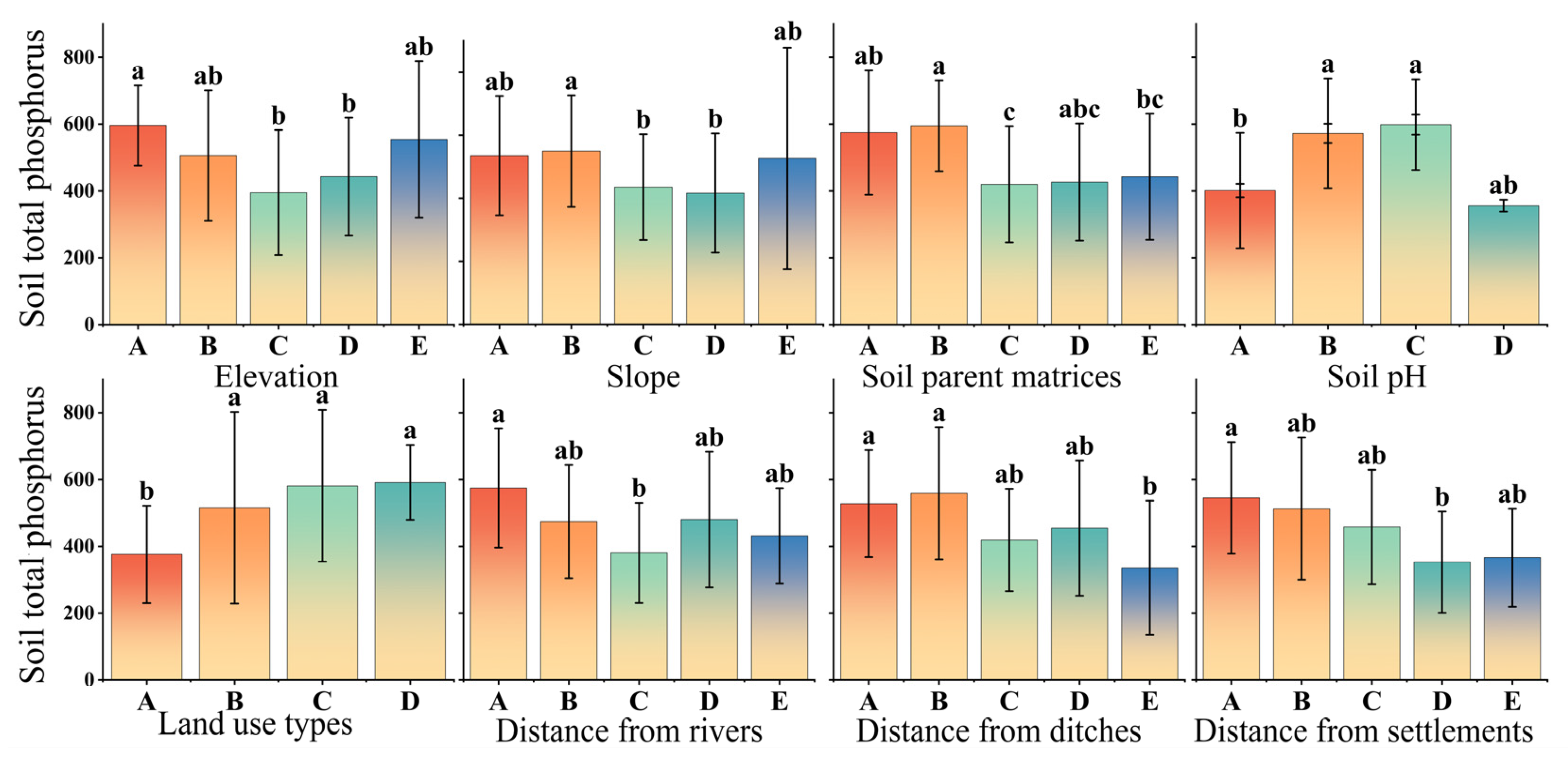
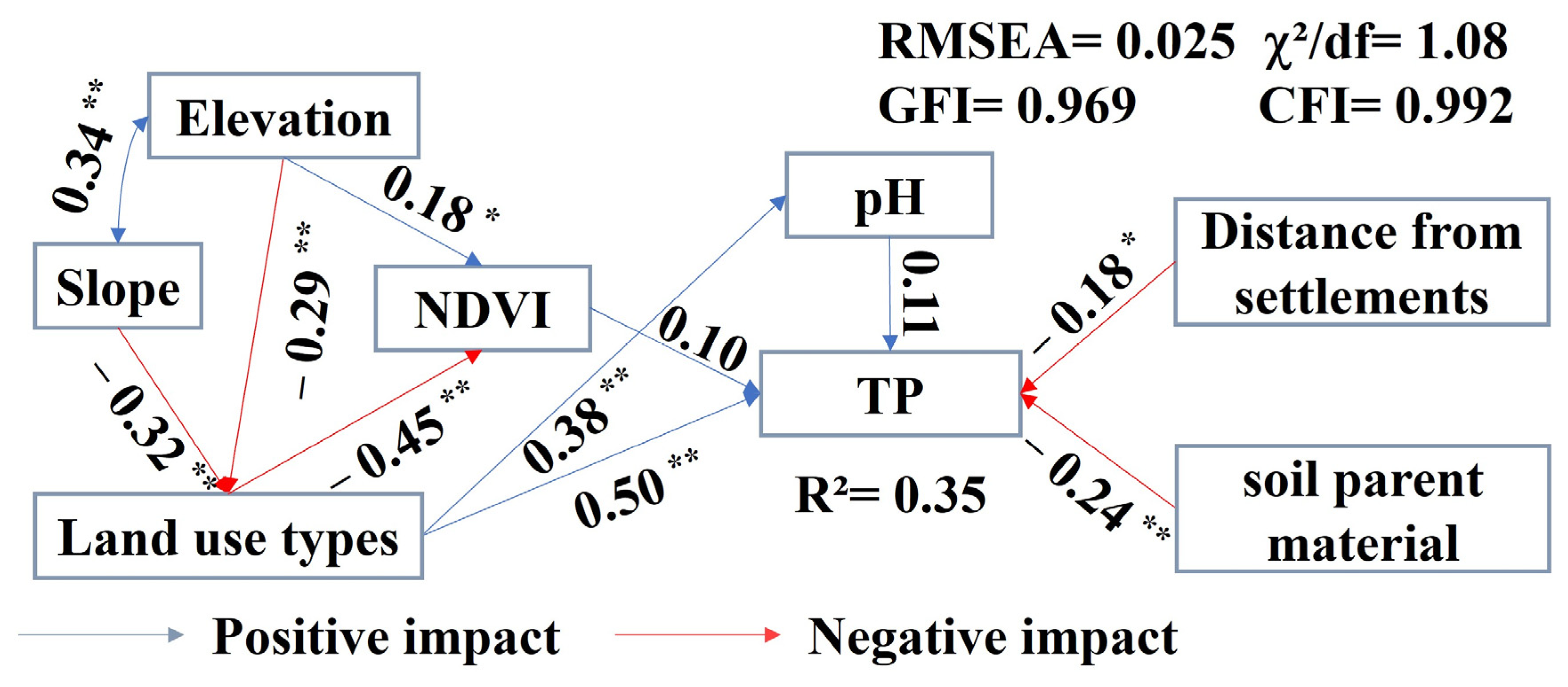
| Norm | Minimum Value | Maximum Values | Median Value | Average Value | Standard Deviation | Variation Coefficients (%) | Kurtosis | Skewness |
|---|---|---|---|---|---|---|---|---|
| Soil total phosphorus/mg/kg | 161 | 991 | 490.50 | 495.71 | 187.18 | 37.76 | −0.54 | 0.29 |
| Elevation/m | 7.00 | 91.75 | 25.30 | 27.93 | 16.82 | 60.23 | 1.69 | 1.23 |
| Slope/° | 0.00 | 20.31 | 3.28 | 3.99 | 2.87 | 71.87 | 5.94 | 1.70 |
| soil pH | 3.74 | 7.19 | 4.56 | 4.64 | 0.46 | 9.93 | 5.11 | 1.56 |
| Distance to rivers/m | 7.77 | 5331.11 | 882.26 | 1120.21 | 1000.08 | 89.28 | 1.59 | 1.21 |
| Distance to ditches/m | 1.00 | 5.00 | 2.00 | 2.20 | 1.27 | 57.79 | −0.53 | 0.77 |
| Distance to settlements/m | 7.49 | 938.87 | 147.64 | 182.88 | 168.77 | 92.28 | 3.69 | 1.67 |
| Influences | Total Effect | Direct Effect | Indirect Effect |
|---|---|---|---|
| Soil parent material | −0.240 | −0.240 | —— |
| Elevation | −0.127 | —— | −0.127 |
| Slope | −0.161 | —— | −0.161 |
| soil pH | 0.114 | 0.114 | —— |
| Land use types | 0.499 | 0.505 | 0.005 |
| NDVI | 0.103 | 0.103 | —— |
| Distance to settlements | −0.178 | −0.178 | —— |
Disclaimer/Publisher’s Note: The statements, opinions and data contained in all publications are solely those of the individual author(s) and contributor(s) and not of MDPI and/or the editor(s). MDPI and/or the editor(s) disclaim responsibility for any injury to people or property resulting from any ideas, methods, instructions or products referred to in the content. |
© 2025 by the authors. Licensee MDPI, Basel, Switzerland. This article is an open access article distributed under the terms and conditions of the Creative Commons Attribution (CC BY) license (https://creativecommons.org/licenses/by/4.0/).
Share and Cite
Jiang, Y.; Huang, J.; Guo, X.; Ye, Y.; Liu, J.; Jiang, Y. Factors Influencing the Spatial Distribution of Soil Total Phosphorus Based on Structural Equation Modeling. Agriculture 2025, 15, 1013. https://doi.org/10.3390/agriculture15091013
Jiang Y, Huang J, Guo X, Ye Y, Liu J, Jiang Y. Factors Influencing the Spatial Distribution of Soil Total Phosphorus Based on Structural Equation Modeling. Agriculture. 2025; 15(9):1013. https://doi.org/10.3390/agriculture15091013
Chicago/Turabian StyleJiang, Yameng, Jun Huang, Xi Guo, Yingcong Ye, Jia Liu, and Yefeng Jiang. 2025. "Factors Influencing the Spatial Distribution of Soil Total Phosphorus Based on Structural Equation Modeling" Agriculture 15, no. 9: 1013. https://doi.org/10.3390/agriculture15091013
APA StyleJiang, Y., Huang, J., Guo, X., Ye, Y., Liu, J., & Jiang, Y. (2025). Factors Influencing the Spatial Distribution of Soil Total Phosphorus Based on Structural Equation Modeling. Agriculture, 15(9), 1013. https://doi.org/10.3390/agriculture15091013






